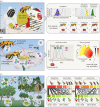The final frontier: ecological and evolutionary dynamics of a global parasite invasion
- PMID: 37222245
- PMCID: PMC10207324
- DOI: 10.1098/rsbl.2022.0589
The final frontier: ecological and evolutionary dynamics of a global parasite invasion
Abstract
Studying rapid biological changes accompanying the introduction of alien organisms into native ecosystems can provide insights into fundamental ecological and evolutionary theory. While powerful, this quasi-experimental approach is difficult to implement because the timing of invasions and their consequences are hard to predict, meaning that baseline pre-invasion data are often missing. Exceptionally, the eventual arrival of Varroa destructor (hereafter Varroa) in Australia has been predicted for decades. Varroa is a major driver of honeybee declines worldwide, particularly as vectors of diverse RNA viruses. The detection of Varroa in 2022 at over a hundred sites poses a risk of further spread across the continent. At the same time, careful study of Varroa's spread, if it does become established, can provide a wealth of information that can fill knowledge gaps about its effects worldwide. This includes how Varroa affects honeybee populations and pollination. Even more generally, Varroa invasion can serve as a model for evolution, virology and ecological interactions between the parasite, the host and other organisms.
Keywords: Apis; invasive species; mites; pollination; viruses.
Conflict of interest statement
We declare we have no competing interests.
Figures

References
Publication types
MeSH terms
LinkOut - more resources
Full Text Sources
